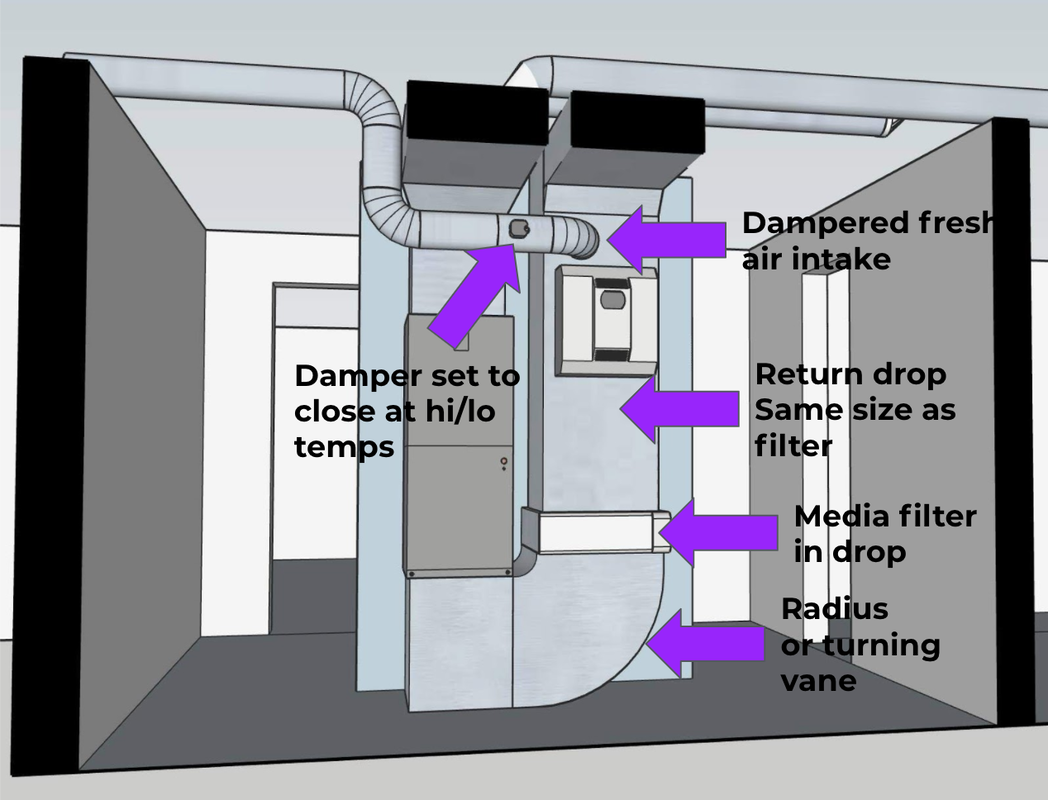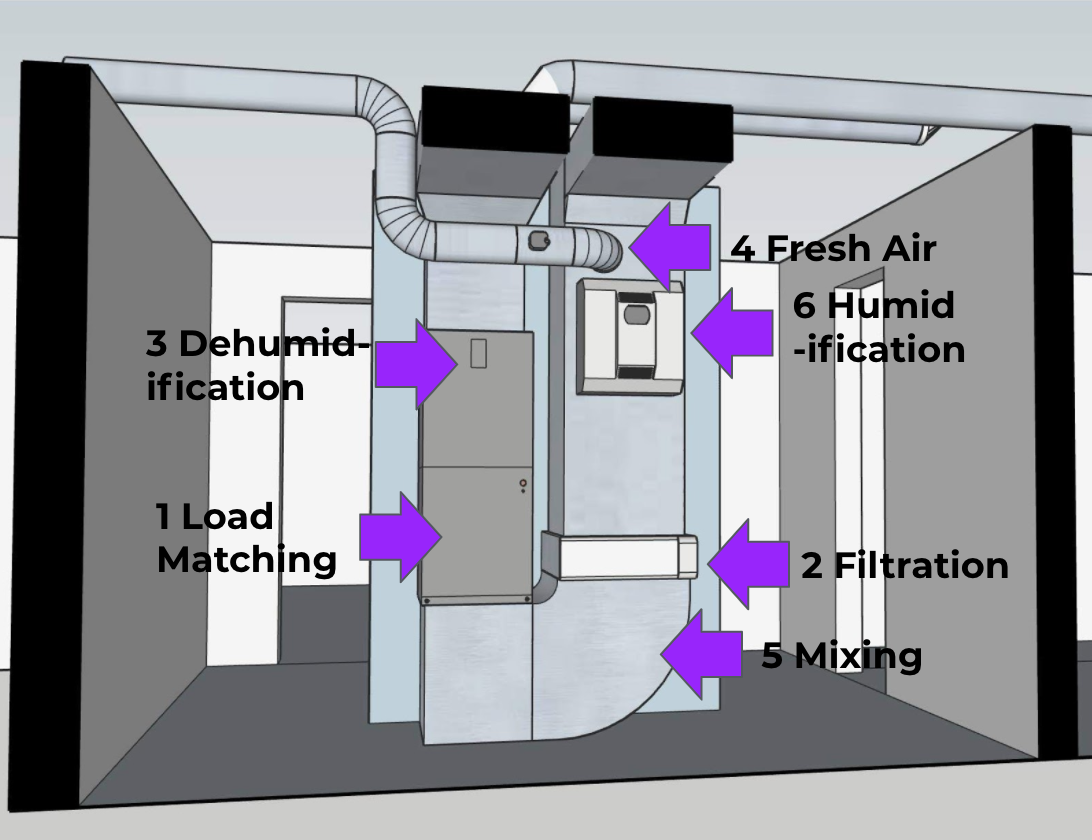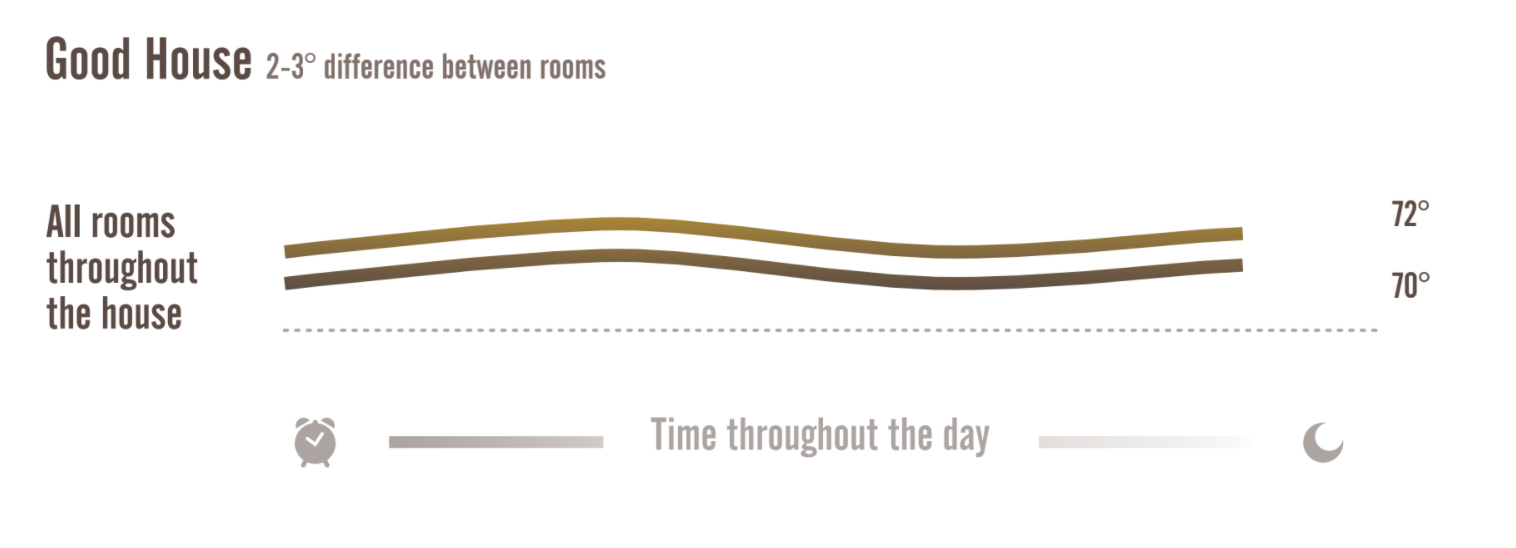|
We’ve finally made it to part 6 where I get to reveal what BAD ASS HVAC actually looks like! BAD ASS HVAC is a fairly simple HVAC system design that can be installed in 90% of homes by 90% of contractors. This design upgrade provides excellent comfort and air quality with very very little user interaction or continuous commissioning effort. In parts 1-4 we worked through the 6 Functions of HVAC and how they are critical to providing comfort and air quality in our homes. In part 5 we talked about the BAD part of BAD ASS HVAC, or the Big Ass Drop, pictured below. (Big Air Drop is the G rated version.) It involves a large return duct with a large filter, ideally with a simple fresh air system attached. In this installment we finish the series and flesh out what the entire BAD ASS HVAC system is and what it looks like. Problem: A BAD, or Big Ass Drop, only provides 3 of the 6 Functions of HVAC What about the other 3? Now we need BAD ASS HVAC. On top of the elements of a BAD, BAD ASS adds a variable speed heat pump, backup resistance heat, and a humidifier. The humidifier may not be called for in all climates, hence it’s the last function of HVAC, but we always recommend it and let the client decide. BAD ASS HVAC = Big Ass Drop, Air Source System Yes, the name is purposely cheeky so it’s sticky. BAD had already proven sticky in the HVAC Facebook groups, so I wanted to build on that and create BAD ASS HVAC. Eric Kaiser, one of our HVAC 2.0 founders, suggested “Air Source System”, and the rest is history. What the ASS in BAD ASS HVAC Looks Like: By putting all that together, you get BAD ASS which provides the 6 Functions of HVAC: Let’s break these down starting with heat pumps. The Importance of Modulating Inverter Driven Heat Pumps Most HVAC systems (furnaces, air conditioners, and heat pumps) come in three varieties:
Modulating heat pumps are almost all “inverter” heat pumps. Inverters convert AC to DC (alternating to direct current) and allow equipment to be modulated across a number of speeds. Back in part one we talked a lot about load matching. If you want a really comfortable home, you want your HVAC to trickle out just the right amount of heating or cooling that the house needs to maintain comfort at that moment. No more, no less. Modulating technology allows us to modulate where once we only had an all on or all off for our firehose of heating or cooling. This warms or cools all the building materials and furnishings in your home, ideally keeping them within 2-3 degrees of what your thermostat says. Rather than sharp peaks and valleys in your home’s temperature, your indoor temperature chart can now looks more like this: Most of the time a house only needs a small fraction of what it takes to heat or cool it on a very hot or cold day. To do this, we need not only modulating equipment, but it usually needs to be the smallest equipment possible, usually much smaller than what people currently have. By putting in the smallest equipment possible we get the most turn down possible. This is where heat pumps start to really excel because they come in sizes with much lower outputs than furnaces. Here’s how furnaces and heat pumps stack up size wise in BTU output. A BTU is a British Thermal Unit or how much energy is released burning a match from head to tail. Gotta love our weird units! What Size HVAC Does My House Need? Dramatically downsizing equipment has always resulted in happier clients. Our ability to downsize equipment is tempered by the concern people will be uncomfortable if the equipment is TOO small for the coldest or hottest day. So we need a way to be both aggressive AND accurate with our sizing. A load calculation helps narrow in on the size HVAC your house needs. The basic load calculation typically performed in the industry, even if done really well, is a highly hypothetical number that has way too much variance for our needs. We see heat loads vary by 30,000 BTUs, or the size of many heat pumps, it’s literally off by an entire piece of equipment. We’d rather be +/- 3,000 BTUs, which is close enough to firmly decide which size HVAC is right for your home. To dramatically increase the accuracy of our load calculations, we true up (or reconcile) our load calculations to both air leakage as measured by a blower door, and actual energy use. (All of this is part of an HVAC 2.0 Comfort Consult by the way.) In other words, without a measured blower door number you might as well size using a dart board. Confirm by comparing the model to past energy use and you significantly increase confidence in your models accuracy. Here is a typical example: Let’s consider a 2000 square foot house in Cleveland that’s fairly tight and well insulated. The load on a house like this will usually come in at about 36,000 BTUs for heating on a 5F day, and 18,000- 24,000 BTUs of cooling on a 90 degree day. The rest of the year though (literally 98%), the house needs much less than full output. Back to this idea of modulating heating and cooling output to match the needs of the house. If you have ever noticed that your house feels particularly cold on a 45-55F day, that’s a key sign that your HVAC is oversized. It runs for a few minutes then shuts off. Your house and the stuff in it stay cold, they never get warmed up. Note in this chart how much of the year different types of HVAC can match what the house needs. Does it surprise you that the very best HVAC can still only match load about ⅔ of the year? Can you see how an oversized furnace never matches what the house needs? Yet a 3 ton modulating heat pump does a nice job on matching what the house needs, and a purposely undersized 2 ton heat pump does even better? The ideal is for HVAC to run at a very low stage 24/7/365. Then everything in your house stays at a nice temperature, plus with BAD ASS HVAC, your air quality is likely to be superb as well. To do that, a heat pump that stages down to as low of an output as possible is the best choice for most homes. When Hybrid Systems are Appropriate If your heat load is significantly higher than a heat pump’s output, we would still strongly recommend using a heat pump, only it would be on top of a furnace. A furnace with a heat pump is called a “hybrid” or “dual fuel” system. By the way, a heat pump is an air conditioner that can not only cool, but heat too. Keep in mind though that with hybrid HVAC you lose one of the 6 Functions: good dehumidification. Which brings us to the next piece. Resistance Heat Strips and Reheat Dehumidification Resistance heat strips are like most things in construction, they have a bunch of names so we can all be confused about what the other person is talking about. They are also known as toasters, emergency heat, or backup heat, among other monikers. Resistance heat strips serve three functions. First they serve as backup heat to help out your heat pump on really cold days if needed. Second, if your compressor ever fails, you have backup heat. And third, they allow for reheat dehumidification if your thermostat has the capability, which we talked about in Part 2. Reheat dehumidification is pretty simple, basically when you put through an air conditioner it gets both dry and cold. On mild days, running your air conditioner in pursuit of drying your house will make your house too cold. Reheat adds back a little heat to the cooled and dried air your air conditioner provides, so you get the drying you want without cooling. The simplest way to do this is with “electric reheat” that turns on those resistance heat strips while the air conditioner is running, warming that air back up. This might sound insane from an energy standpoint. But as we discussed in Part 2, on our clients’ homes we are seeing it cost $15-100/year. That’s less than many spend running their standard dehumidifiers. Simplicity of Design and Operation By using electric reheat dehumidification, we use equipment that already exists - the heat pump and the resistance electric backup - and put it to a different use. It does require different programming, but avoids the need for another expensive piece of equipment. High quality, high capacity whole home dehumidifiers typically cost about $3000-5000. If that same $3-5K is put into the main HVAC system you can step up from a basic single stage piece of crap to a high end modulating heat pump. Dehumidification with Hybrid HVAC If you’re chicken and don’t want to go heat pump only (or it’s just not a good idea for your climate), you can do a separate whole home dehumidifier, those systems look like this: Keep in mind though, this design adds a fair amount of cost and complexity. Now you have a second piece of equipment and thermostat that needs to be managed and maintained. Often the equipment will have different lifespans too, so you may have to replace one before the other needs it.
That said, if you recently bought new HVAC that’s oversized and you’re having high humidity challenges, a whole home dehumidifier would likely be one of our top recommendations. We do use them in our practice. But Wait, Do Heat Pumps Really Work In Cold Climates? Heat pumps have a bad rep, and frankly until inverters became common about 10 years ago, they deserved it. They tended to leave houses feeling cold and uncomfortable. Do they work now? If you haven’t figured out that they do after reading this column for a while, you may need a good smack upside the head, but next time we’ll talk more about exactly that. We’ll also talk about humidifiers. Until then, I’ll leave you with this summary of the elements of BAD ASS HVAC. See you next time! |
AuthorNate Adams is fiercely determined to get feedback on every project to learn more about what works and what doesn't. This blog shows that learning process. |
ServicesCompany |
Buy The Home Comfort Book!
© COPYRIGHT 2017. ALL RIGHTS RESERVED.
|
 RSS Feed
RSS Feed











